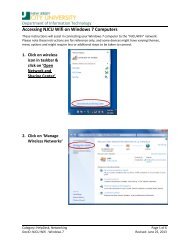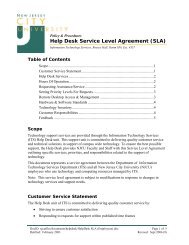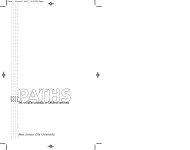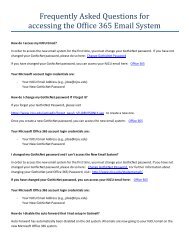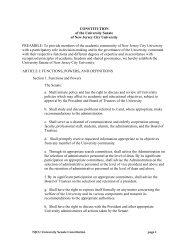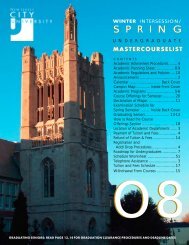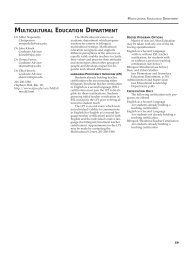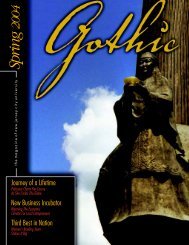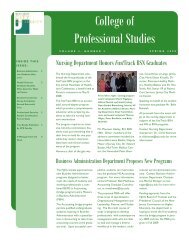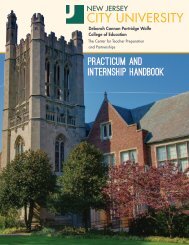UACHS 9th English Unit- Feed[1] - New Jersey City University
UACHS 9th English Unit- Feed[1] - New Jersey City University
UACHS 9th English Unit- Feed[1] - New Jersey City University
You also want an ePaper? Increase the reach of your titles
YUMPU automatically turns print PDFs into web optimized ePapers that Google loves.
Content Area: <strong>English</strong>Target Course/Grade Level: 9 th Grade!"#$%&'()'#(*+%,((-Duration: 3-4 weeks<strong>Unit</strong> Summary: During this unit, students will read <strong>Feed</strong> by M.T. Anderson. Students will define satireand will apply that definition to this book. We will focus on how satire can illuminate aspects of oureveryday life, such as advertising and media in general, and how a satire can challenge our idea of what isnormal. A major goal is for students to evaluate why it is important to have our understanding of normaldisrupted, similar to the experience of the protagonist, Titus.The <strong>Feed</strong> unit will fall as one of the first books of the year the Freshmen will read. Much of the discussionwill be sociologically based as students will begin to question their role in the world. Identity will be atheme for the entire year, and this close look at Titus’s identity will serve as a base for future discussionson identity where it is important to question roles. For example, <strong>Feed</strong> will be followed by Lord of theFlies. The two novels will work well back-to-back as one is satire about a futuristic society where thingsare so advanced the characters do not have to think for themselves, while the other (LOTF) portrays asociety completely stripped of any modernisms or luxuries. The two books will enhance discussions aboutadolescent identity, specifically how our environment shapes our identity.Primary interdisciplinary connections: Sociology and Business: Students could take a closer look atmarketing and advertising in our society, investigating how we make decisions as consumers.21 st century themes/skills: Creativity and innovation, collaboration and communication, GlobalAwareness, Life and Career Skills, Business LiteracyService learning: N/A<strong>Unit</strong> Rationale: This unit highlights elements of critical reading, such as asking questions and uncoveringmeaning, and applies them to the world more generally by asking students to think about how ourlifestyles and perceptions of normal are shaped by dominant cultural norms and by technology and media.The objective of the unit is to encourage students to become active readers both of literature and ofsociety. Students will become agents in the formation of their norms rather than mere consumers of thenorms dictated to us. <strong>Feed</strong> encourages us to question what is normal through the narrative as Titus’sunderstanding of the world is questioned by his girlfriend, Violet, and also in its function as a satire..(/)"#"0%1/)0($2Standards• Reading Standards for Literature 9-10: Key Ideas and Details• Reading Standards for Literature 9-10: Craft and Structure• Reading Standards for Literature 9-10: Range of Reading and Level of Text Complexity• Reading Standards for Informational Text 9-10: Key Ideas and Details• Reading Standards for Informational Text 9-10: Craft and Structure• Reading Standards for Informational Text 9-10: Integration of Knowledge and Ideas• Writing Standards 9-10: Text Types and Purposes• Writing Standards 9-10: Research to Build and Present Knowledge• Writing Standards 9-10: Range of Writing• Speaking and Listening Standards 9-10: Comprehension and Collaboration• Speaking and Listening Standards 9-10: Presentation of Knowledge and Ideas• Language Standards 9-10: Conventions of Standard <strong>English</strong>
• Language Standards 9-10: Knowledge of Language• Language Standards 9-10: Vocabulary Acquisition and UseCPI # Cumulative Progress Indicator (CPI)RL.9-10.1RL.9-10.4RIT.9-10.1RIT.9-10.4RIT.9-10.5SL.9-10.1SL.9-10.4SL.9-10.6L.9-10.1L.9-10.3L.9-10.4Cite strong and thorough textual evidence to support analysis of what the text says explicitly as well as inferences drawnfrom the text.Determine the meaning of words and phrases as they are used in the text, including figurative and connotative meanings;analyze the cumulative impact of specific word choices on meaning and tone (e.g., how the language evoke a sense of timeand place; how it sets a formal or informal tone).Cite strong and thorough textual evidence to support analysis of what the text says explicitly as well as inferences drawnfrom the text.Determine the meaning of words and phrases as they are used in a text, including figurative, connotative, and technicalmeanings; analyze the cumulative impact of specific word choices on meaning and tone (e.g., how the language of a courtopinion differs from that of a newspaper).Analyze in detail how an author’s ideas or claims are developed and refined by particular sentences, paragraphs, or largerportions of a text (e.g., a section or chapter).Initiate and participate effectively in a range of collaborative discussions (one-on-one, in groups, and teacher-led) withdiverse partners on grades 9–10 topics, texts, and issues, building on others’ ideas and expressing their own clearly andpersuasively.Present information, findings, and supporting evidence clearly, concisely, and logically such that listeners can follow the lineof reasoning and the organization, development, substance, and style are appropriate to purpose, audience, and task.Adapt speech to a variety of contexts and tasks, demonstrating command of formal <strong>English</strong> when indicated or appropriate.(See grades 9–10 Language standards 1 and 3 on pages 54 for specific expectations.)Demonstrate command of the conventions of standard <strong>English</strong> grammar and usage when writing or speaking.Apply knowledge of language to understand how language functions in different contexts, to make effective choices formeaning or style, and to comprehend more fully when reading or listening.Determine or clarify the meaning of unknown and multiple-meaning words and phrases based on grades 9–10 reading andcontent, choosing flexibly from a range of strategies.<strong>Unit</strong> Essential Questions• What is normal and how is it defined? Howmight normal be mistaken for ideal?• How can other people disrupt ourunderstanding of normal? Why is it valuableto have our understandings of normaldisrupted?• How can criticizing the norms of our societyempower us to make our own decisionsabout what we think is best?• How can encountering people who are orthings that are different than we are bebeneficial and help us look at the world in anew and better way?• As a consumer and citizen of the world am Itoo easily manipulated by the media? Do Ihave my own ideals that come from placesother than the media or am I shaped by themedia?• How influential is the media in our society?Does any other medium challenge themedia, such as schools, religion or politics?<strong>Unit</strong> Enduring Understandings• Our understandings of “normal”—how welive, what we think and value—are shaped bythe society in which we live and the messagesit sends via the media.• When we don’t think critically about our“normal”—how it is defined and by whom—we run the risk of mistaking normal for ideal.• Encountering other versions of normal—through stories of people who are differentfrom us or through literature—helps us tothink critically about our understanding of“normal” empowering us to choose what isbest instead of having ideals fed to us by thedominant culture.• People often confuse normal with ideal and, indoing so, can sometimes mistake a dystopiafor a utopia.• Our sense of normal is largely defined by theculture around us—by all the things we neverthink about because we’re so used to them.• Satirical texts (<strong>Feed</strong>) disrupt readers’ normalby taking things that are normal just a little bit
too far so that they begin to look abnormal andbecome subjects for criticism.<strong>Unit</strong> Learning TargetsStudents will ...• Read and interpret how characters’ actions, speech, thoughts, and feelings reflect societalnorms.• Explain the following concepts: normal, ideal, utopia and dystopia (assessed throughworksheets and class discussion.)• Interpret the short film “2081” as a critique of a society in order to draw connections to <strong>Feed</strong> bylooking how a story thematically different than <strong>Feed</strong> can have a similar effect on the reader orviewer.• Read and interpret the significance of perceived differences by comparing Titus’s and Violet’sdistinctive experiences of normal (assessed through journal responses and small groupdiscussions.)3'#-("4(%56%.(/)"#"0%Summative AssessmentSW critique an advertisement (in a magazine, on a billboard, or a TV commercial) to determinewhat subtle messages about how society should think the ad is communicating. SW create an adthat responds to one of the subtle messages they uncovered. SW present their “Ads of Resistance”to the class, describing the original ad to which they are responding and how and why theycreated their ad of resistance.Equipment needed: Presentations could require computers with PowerPoint and a digital projector withlaptop.Teacher Resources:KEY MATERIALS: copies of <strong>Feed</strong>.SUGGESTED SUPPLEMENTARY MATERIALS: ads found on the internet, TV, or printadvertisements.Formative Assessments• Literary response journal entries• Quizzes on reading• Roundtable discussion self-assessments.(225"%78/"2%%LessonLesson 1Satire We Watch on TVLesson 2Disrupt My RoutineLesson 3EmpathyOther Suggested Activities: Lesson on using proper MLA style• Critical reading questions on “HarrisonBergeron” and “2081.”• Reflective essay: 1-2 pg. essay focused on oneof the norms of society satirized in <strong>Feed</strong> that isalso a norm in our own society.Timeframe1 45-min. class period2 45-min. class periods1 45-min. class period
Teacher Notes: <strong>Feed</strong> should be a potent resource for encouraging students to examine their daily routinesand to recognize how dependent our society is on technology. There is potential for many exercises thatwill encourage students to question their approach to life. It will be important to elucidate the meaningbehind the futuristic slang in the novel and the futuristic lifestyle in the book.
!"#$%&'()'#(*+%!"#$%"&%'()%*+,)-%,"-%./*%0/%1(%2)(,$(%,%3/4#($5%67,$%1/)89%:/)%;'()5/"(%6,)>($9Standards:• Reading Standards for Literature 9-10: Key Ideas and Details• Reading Standards for Literature 9-10: Craft and Structure• Reading Standards for Literature 9-10: Integration of Knowledge and Ideas• Reading Standards for Literature 9-10: Range of Reading and Level of Text Complexity
• Reading Standards for Informational Text 9-10: Key Ideas and Details• Reading Standards for Informational Text 9-10: Craft and Structure• Reading Standards for Informational Text 9-10: Integration of Knowledge and Ideas• Writing Standards 9-10: Text Types and Purposes• Writing Standards 9-10: Production and Distribution of Writing• Writing Standards 9-10: Research to Build and Present Knowledge• Writing Standards 9-10: Range of Writing• Speaking and Listening Standards 9-10: Comprehension and Collaboration• Speaking and Listening Standards 9-10: Presentation of Knowledge and Ideas• Language Standards 9-10: Conventions of Standard <strong>English</strong>• Language Standards 9-10: Knowledge of Language• Language Standards 9-10: Vocabulary Acquisition and UseCPI # Cumulative Progress Indicator (CPI)RL. 9-10.1RL.9-10.2RL.9-10.3W.9-10.1W.9-10.2W.9-10.4W.9-10.9SL.9-10.1SL.9-10.2SL.9-10.3SL.9-10.4SL.9-10.6L.9-10.1L.9-10.4Cite strong and thorough textual evidence to support analysis of what the text says explicitly as well as inferences drawnfrom the text.Determine a theme or central idea of a text and analyze in detail its development over the course of the text, including how itemerges and is shaped and refined by specific details; provide an objective summary of the text.Analyze how complex characters (e.g., those with multiple or conflicting motivations) develop over the course of a text,interact with other characters, and advance the plot or develop the theme.Write arguments to support claims in an analysis of substantive topics or texts,using valid reasoning and relevant andsufficient evidence.Write informative/explanatory texts to examine and convey complex ideas, concepts, and information clearly and accuratelythrough the effective selection, organization, and analysis of content.Produce clear and coherent writing in which the development, organization, and style are appropriate to task, purpose, andaudience.Draw evidence from literary or informational texts to support analysis, reflection, and research.Initiate and participate effectively in a range of collaborative discussions (one-on-one, in groups, and teacher-led) withdiverse partners on grades 9–10 topics, texts, and issues, building on others’ ideas and expressing their own clearly andpersuasively.Integrate multiple sources of information presented in diverse media or formats (e.g., visually, quantitatively, orally)evaluating the credibility and accuracy of each source.Evaluate a speaker’s point of view, reasoning, and use of evidence and rhetoric, identifying any fallacious reasoning orexaggerated or distorted evidence.Present information, findings, and supporting evidence clearly, concisely, and logically such that listeners can follow the lineof reasoning and the organization, development, substance, and style are appropriate to purpose, audience, and task.Adapt speech to a variety of contexts and tasks, demonstrating command of formal <strong>English</strong> when indicated or appropriate.Demonstrate command of the conventions of standard <strong>English</strong> grammar and usage when writing or speaking.Determine or clarify the meaning of unknown and multiple-meaning words and phrases based on grades 9–10 reading andcontent, choosing flexibly from a range of strategies.<strong>Unit</strong> Essential Questions• How can extreme situations affect one’sidentity, actions, and attitudes?• How does the way others see us affect theway we see ourselves?• How does the way we see others affect howwe treat them?• How does social environment affectidentity?• How can a society that works for everyone<strong>Unit</strong> Enduring Understandings• Extreme circumstances and/or abrupt changescan dramatically affect a person’s personality,actions, and identity.• Writers often use symbolism to convey deepermeanings within a text.• Writers often use the structure and style oftheir writing to convey sensory and emotionalaspects of a text.• Characters are often used to represent abstractqualities and ideas (e.g., rationality, barbarity)
e achieved?• How does the style and structure of a novelrelate to its meaning?• Are there different ways of establishing andwielding power?• How are characters used to representabstract qualities and ideas and/orconflicts/tensions between them?and/or conflicts/tensions between them.• The setting can sometimes serve almost as acharacter in a novel, through personification.• Problems in our communities are often relatedto inequity or oppression, and characterized byperceptions about race, class, gender,language, and age.• The characteristics of a community can oftenfoster and reinforce inequities.• A person’s actions and attitudes impact thecommunities in which they participate -- inschool, at home, at work, on a team, amongfriends.• A person’s actions and attitudes can eithercontribute to the reinforcement of racial,gender, class or language inequities, or theycan help dismantle them.• There are different ways of establishing andwielding authority.• Laws and social institutions quickly erode inthe absence of authority.<strong>Unit</strong> Learning TargetsStudents will ...• analyze how problems in our communities are often related to inequity or oppression, andcharacterized by perceptions about race, class, gender, language, and age;• evaluate how the characteristics of a community can often foster and reinforce inequities;• evaluate how their own actions and attitudes impact the communities in which they participate -- in school, at home, at work, on a team, among friends – and how they can either contribute tothe reinforcement of racial, gender, class or language inequities, or help dismantle them;• analyze and evaluate how the characters in Lord of the Flies illustrate the causes and effects ofsocial inequity;• analyze and evaluate how the style and structure of Golding’s text and his use of symbolismhelp convey the novel’s themes.;'#-("4(%/:%=(,)"#">%Summative AssessmentA 3-4 page essay reflecting on the group project and connections with Lord of the Flies andaddressing unit essential questionsEquipment needed: Computers with Microsoft Publisher, GoogleDocs, WikiSpaces (or some other onlinecollaboration tool)Teacher Resources:KEY MATERIALS: Lord of the Flies, handouts on Maslow’s hierarchy of needs, websites on past andpresent utopian communities
SUGGESTED SUPPLEMENTARY MATERIALS: film versions of Lord of the Flies, episodes of Lost,Stanford Prison Experiment website, model travel brochuresFormative Assessments• Daily individual and group selfassessments• Community design plan• Design plan presentation• Quizzes on Lord of the Flies and vocabulary• Character journal=(99/"%?@,"9%%LessonTimeframeLesson 11 45-minute periodIntroductory Instructional ConversationLesson 22 45-minute periodsDiscussion of Interview Findings and theImpacts of Inequity on CommunitiesLesson 31 45-minute periodMaslow’s Hierarchy of NeedsOther Suggested Activities:• Read-aloud passages heavy on setting description and have students underline parts that convey anemotional feeling or tone• Compare film versions of the novel, especially the beginnings (Ms. Chenelle has these on DVD)Teacher Notes: The group project in this unit was conceived with a classroom that has multiple computersin mind. If students do not have sufficient access to computers to create a brochure and/or PowerPoint,low-tech presentation materials (e.g., posterboard) could be substituted.Ms. Chenelle has a more comprehensive description of the rationale for this unit and the group project,additional lesson plans, and materials available.
Content Area: <strong>English</strong>Target Course/Grade Level: 9 th Grade!"#$%&'()'#(*+%,-)(..%/"0%1("0)/Duration: 3-4 weeks / 2-3 weeks (honors)<strong>Unit</strong> Summary: During this unit, students will read two young adult novels by Coe Booth. They willanalyze and evaluate the description, dialogue, and plot of the novels for their authenticity. Students willread both books and then compare how each novel deals with a particular common theme in a 5-minutesmall group oral presentation. They will also read recent news articles about the issues that teenagers facegrowing up in poor urban communities and compare how they discuss these issues with how they arerepresented in the novels.Primary interdisciplinary connections: Sociology: students could analyze and discuss sociologicalstudies on the problems that teenagers face growing up in poor urban neighborhoods.21 st century themes/skills: Creativity and innovation, collaboration and communicationService learning: N/A<strong>Unit</strong> Rationale: The rationale for this unit is that these two books are engaging novels about urban teensdealing with situations very similar to those that our own students go through. The themes in both of thesenovels are directly in line with the course theme and essential questions for <strong>English</strong> I. The rationale forhaving students read both of these books is that it is often difficult to get male students interested in anovel about a female protagonist, and any resistance or lack of interest on their part could create someinteresting discussions. Students can also analyze how the opposite sex is portrayed in each novel andmake connections between events in the novel and situations in their own lives.2(/)"#"3%,/)3($4Standards• Reading Standards for Literature 9-10: Key Ideas and Details• Reading Standards for Literature 9-10: Craft and Structure• Reading Standards for Literature 9-10: Range of Reading and Level of Text Complexity• Reading Standards for Informational Text 9-10: Key Ideas and Details• Reading Standards for Informational Text 9-10: Craft and Structure• Reading Standards for Informational Text 9-10: Integration of Knowledge and Ideas• Writing Standards 9-10: Text Types and Purposes• Writing Standards 9-10: Research to Build and Present Knowledge• Writing Standards 9-10: Range of Writing• Speaking and Listening Standards 9-10: Comprehension and Collaboration• Speaking and Listening Standards 9-10: Presentation of Knowledge and Ideas• Language Standards 9-10: Conventions of Standard <strong>English</strong>• Language Standards 9-10: Knowledge of Language• Language Standards 9-10: Vocabulary Acquisition and UseCPI # Cumulative Progress Indicator (CPI)RL.9-10.1RL.9-10.4RIT.9-10.1RIT.9-10.4Cite strong and thorough textual evidence to support analysis of what the text says explicitly as well as inferences drawnfrom the text.Determine the meaning of words and phrases as they are used in the text, including figurative and connotative meanings;analyze the cumulative impact of specific word choices on meaning and tone (e.g., how the language evoke a sense of timeand place; how it sets a formal or informal tone).Cite strong and thorough textual evidence to support analysis of what the text says explicitly as well as inferences drawnfrom the text.Determine the meaning of words and phrases as they are used in a text, including figurative, connotative, and technical
RIT.9-10.5SL.9-10.1SL.9-10.4SL.9-10.6L.9-10.1L.9-10.3L.9-10.4meanings; analyze the cumulative impact of specific word choices on meaning and tone (e.g., how the language of a courtopinion differs from that of a newspaper).Analyze in detail how an author’s ideas or claims are developed and refined by particular sentences, paragraphs, or largerportions of a text (e.g., a section or chapter).Initiate and participate effectively in a range of collaborative discussions (one-on-one, in groups, and teacher-led) withdiverse partners on grades 9–10 topics, texts, and issues, building on others’ ideas and expressing their own clearly andpersuasively.Present information, findings, and supporting evidence clearly, concisely, and logically such that listeners can follow the lineof reasoning and the organization, development, substance, and style are appropriate to purpose, audience, and task.Adapt speech to a variety of contexts and tasks, demonstrating command of formal <strong>English</strong> when indicated or appropriate.(See grades 9–10 Language standards 1 and 3 on pages 54 for specific expectations.)Demonstrate command of the conventions of standard <strong>English</strong> grammar and usage when writing or speaking.Apply knowledge of language to understand how language functions in different contexts, to make effective choices formeaning or style, and to comprehend more fully when reading or listening.Determine or clarify the meaning of unknown and multiple-meaning words and phrases based on grades 9–10 reading andcontent, choosing flexibly from a range of strategies.<strong>Unit</strong> Essential Questions• How do authors make a story seem real orauthentic?• Can an author write an authentic story abouta character of a different gender (orrace/ethnicity, etc.) than they are?• How can young people deal with thecircumstances and situations life throws atthem?• When life throws bad situations at people –especially people with few resources – dothe principles of right and wrong in dealingwith them still apply?• How does the absence of reliable parentingaffect teenagers?• What can teen readers get out of readingstories about characters’ whose lives aresimilar to their own?• Can fiction tell the truth?• What are the respective uses of fictionalnarratives and nonfiction articles?<strong>Unit</strong> Enduring Understandings• Authors use dialogue (including slang) anddetails to create authenticity in their works.• Learning and choosing to how deal with thecircumstances and situations life throws you isa critical part of growing up.• When people make choices – whether they’reconsidered right or wrong – there are alwaysconsequences that have to be lived with.• When people make choices, they don’t alwaysknow what the consequences might be or whothey might affect.• The themes in a creative work often suggest anessential idea or belief that the author is tryingto convey.• Reading stories about difficult situationspeople go through can help give readersinsight into how to understand and deal withthe difficult situations in their own lives.• Differences in types of writing are often due todifferences in audience, purpose and genre.<strong>Unit</strong> Learning TargetsStudents will ...• Read and analyze novel passages in order to evaluate their authenticity and identify elementsthat contribute to their authenticity/credibility.• Read and analyze short non-fiction essays or articles in order to evaluate their authenticity andidentify elements that contribute to their authenticity/credibility.• Work in small groups in order to conduct a literature circle about reading material.• Work in small groups in order to analyze and evaluate character actions and to compare tosituations in their own lives.• Work in small groups in order to create and deliver a 5-minute oral presentation comparing the
two novels.5'#0("6(%78%2(/)"#"3%Summative AssessmentSW work in small groups to create and deliver a 5-min. oral presentation comparing the twonovels.Equipment needed: Presentations could require computers with PowerPoint and a digital projector withlaptop.Teacher Resources:KEY MATERIALS: copies of Tyrell and KendraSUGGESTED SUPPLEMENTARY MATERIALS: recent news articles or sociological studies abouturban teens and/or issues faced by urban teensFormative Assessments• Literary response journal entries• Quizzes on reading• Literature circle discussion selfassessments2(447"%9./"4%%LessonLesson 1Find Something RealLesson 2Literature CircleLesson 3Fact vs. FictionOther Suggested Activities: Lesson on using proper MLA style• Critical reading questions on news articles• 1-2 page article summaries and/or expositoryessays on a particular issue relevant to urbanteensTimeframe1 45-min. class period1 45-min. class period1 45-min. class periodTeacher Notes: There are different ways this unit could be taught, depending on time, resources, studentsand goals. The class could read one novel, then the other. Or, students could read the novel about thecharacter of the same sex, and then switch.
Content Area: <strong>English</strong>Target Course/Grade Level: <strong>English</strong> I/9 th Grade!"#$%&'()'#(*+%,-$./0/1-Duration: 4 weeks<strong>Unit</strong> Summary: This unit focuses on detailed analysis of traditional and contemporary epics and therelationship between the struggles of fictional characters and real-life situations. In ongoing activities,students will respond to a variety of writing prompts in a journal, define and use vocabulary words withinthe context of the literature, and construct a list of important literary terms.Primary interdisciplinary connections: Students can gain a great deal of historical and sociologicalperspectives by examining the cultural dynamics of Greek civilization.<strong>Unit</strong> Rationale: Homer's Odyssey is one of Greek civilizations' most lasting works. It has had atremendous influence on all aspects of the arts-- some obvious examples are music, literature, and evenfilm. The epic story of a man's long-awaited homecoming after many years at war and at sea is one thatcan be appreciated no matter what the age-- because it is a story of universality. In reading the Odyssey,one can learn a lot of ancient Greek culture and history, as well as begin to understand better thedevelopment of our own culture and our ideas.2(3)"#"1%43)1($5Standards• Reading Standards for Informational Text: Key Ideas and Details• Reading Standards for Informational Text: Craft and Structure• Writing Standards 9-10: Text Types and Purposes• Writing Standards 9-10: Research to Build and Present Knowledge• Speaking and Listening Standards 9-10: Comprehension and Collaboration• Speaking and Listening Standards 9-10: Presentation of Knowledge and Ideas• Language Standards 9-10: Conventions of Standard <strong>English</strong>CPI #RI.9-10.1.RI.9-10.2.RI.9-10.3.RI.9-10.4.RI.9-10.5.Cumulative Progress Indicator (CPI)Cite strong and thorough textual evidence to support analysis of what the text saysexplicitly as well as inferences drawn from the text, including determining wherethe text leaves matters uncertain.Determine two or more central ideas of a text and analyze their development over/the course of the text, including how they interact and build on one another toprovide a complex analysis; provide an objective summary of the textAnalyze a complex set of ideas or sequence of events and explain how specificindividuals, ideas, or events interact and develop over the course of the text.Determine the meaning of words and phrases as they are used in a text, includingfigurative, connotative, and technical meanings; analyze how an author uses andrefines the meaning of a key term or terms over the course of a text (e.g., howMadison defines faction in Federalist No. 10).Analyze and evaluate the effectiveness of the structure an author uses in his or herexposition or argument, including whether the structure makes points clear,convincing, and engaging.
RI.9-10.6.W.9-10.1.W.9-10.2.W.9-10.3.W.9-10.9.SL.9-10.1.SL.9-10.4.L.9-10.1.L.9-10.2.<strong>Unit</strong> Essential QuestionsDetermine an author’s point of view or purpose in a text in which the rhetoric isparticularly effective, analyzing how style and content contribute to the power,persuasiveness or beauty of the text.Write arguments to support claims in an analysis of substantive topics or texts,using valid reasoning and relevant and sufficient evidence.Write informative/explanatory texts to examine and convey complex ideas,concepts, and information clearly and accurately through the effective selection,organization, and analysis of content.Write narratives to develop real or imagined experiences or events using effectivetechnique, well-chosen details, and well-structured event sequences.Draw evidence from literary or informational texts to support analysis, reflection,and researchInitiate and participate effectively in a range of collaborative discussions (one-onone,in groups, and teacher-led) with diverse partners on grades 11–12 topics, texts,and issues, building on others’ ideas and expressing their own clearly andpersuasivelyPresent information, findings, and supporting evidence, conveying a clear anddistinct perspective, such that listeners can follow the line of reasoning, alternativeor opposing perspectives are addressed, and the organization, development,substance, and style are appropriate to purpose, audience, and a range of formaland informal tasks.Demonstrate command of the conventions of standard <strong>English</strong> grammar and usagewhen writing or speaking.Demonstrate command of the conventions of standard <strong>English</strong> capitalization,punctuation, and spelling when writing.<strong>Unit</strong> Enduring Understandings•What is the relationship between decisionsand consequences?• How do we know how to make gooddecisions?• How can a person's decisions and actionschange his/her life?• How do the decisions and actions ofcharacters reveal their personalities?• How do decisions, actions, andconsequences vary depending on the differentperspectives of the people involved?• Do the attributes of a hero remain the sameover time?• When does a positive personality traitbecome a tragic flaw?• What is the role of a hero in a culture?• The Ancient Greeks sought todistinguish themselves on thebattlefield and through other heroicdeeds in this life rather thanemphasizing the afterlife.• The social structure of Ancient Greece isfundamentally different than Americansociety.• Societies have different rules forhospitality, revenge and justice, andmoral behavior.• Some aspects of Odysseus would still beconsidered heroic today, and others area specific aspect of Ancient Greekculture.
• How do various cultures reward / recognizetheir heroes?• Does a hero have a special responsibilitybecause of their "hero" status?• Why is it important for people/cultures toconstruct narratives about their experience?• What is the relevance of studyingmulticultural texts?• What can you learn about yourself bystudying the lives of others?• What universal characteristics of beliefsystems that are common across people andtime?• How are belief systems represented andreproduced through history, literature, art, andmusic?• The Ancient Greek conception of thedivine is fundamentally different thanother organized theologies.• The expectations of a ‘hero’ differ thanthose of an ordinary citizen.• Narratives help document the strugglesand triumphs of society.• Understanding the culture practices ofdifferent societies helps build respectand tolerance towards others.• We can learn as much from ourdifferences as we do from oursimilarities.• There are universal themes that apply toall cultures and societies.• The arts provide a deeper understandingof historical facts and context.<strong>Unit</strong> Learning TargetsStudents will ...• read The Odyssey to begin building an understanding of Greek mythology.• understand the role of the hero and myth in The Odyssey.• identify and recognize the importance of key Greek Gods/Goddesses to Greek life.• use a variety of technological resources to learn about Homer, Greek culture, andmythology.• analyze recognized works of world literature from a variety of authors.• •contrast major literary forms, techniques, and characteristics of Homeric Greece andmodern.• be able to revisit what they read and apply the information to a new format.• effectively communicate information to a variety of audiences for various purposes.6'#7("8(%/9%2(3)"#"1%Summative Assessment• Students will apply reading strategies to interpret themes and objectives. The class will beresponsible for the planning and creation of a comic strip style mythologicalnarrative.Equipment needed: Laptop, digital projector, computers with internet accessTeacher ResourcesKEY MATERIALS: The Odyssey by HomerSUGGESTED SUPPLEMENTARY MATERIALS: The film O Brother, Where Art Thou? (2000), Criticalcommentary and poetry.Formative Assessments• 4 page Critical Analysis• 1-2 page critical reading response to text• Cornell Notes• MLA Source Cards
LessonHero Hall of Fame2(55/"%:03"5%%Timeframe45 mins/ 1dayThe Meaning of Myth45 mins/2 dayOrigins of Sexism in Early Myths45 mins/ 1 dayOther Suggested Activities: This unit could work well as an introduction into Romeo and Juliet andShakespeare in general, driving home the concept the inspiration of ancient myths on the modern daycanon of literature..Teacher Notes:
Content Area: <strong>English</strong>Target Course/Grade Level: <strong>English</strong> I / <strong>9th</strong>!"#$%&'()'#(*+%,-.(-%/"0%123#($Duration: 4-5 weeks<strong>Unit</strong> Summary: During this unit, students will read and act aloud Shakespeare’s Romeo and Juliet, andprepare to present selected scenes as part of a school-wide Shakespeare festival. They will also view andevaluate selected scenes from one or more film versions of the play. During their analysis of the play, theywill draw connections between Shakespeare’s Verona and present-day <strong>Jersey</strong> <strong>City</strong>. The summativeassessments for the unit will be students’ performance and contributions to the Shakespeare festival and a4-5 page essay identifying three lessons students can learn from the play that are relevant to their presentdaylives.Primary interdisciplinary connections: Art – creating sets and costumes; history – learning more aboutShakespeare’s time, especially social institutions21 st century themes/skills: Creativity and innovation, communication and collaborationService learning: Shakespeare festival<strong>Unit</strong> Rationale: The rationales for this unit are that Romeo and Juliet fits well with the course theme ofidentity and it is a story that our students easily relate to in their lives as teenagers in present-day <strong>Jersey</strong><strong>City</strong>. Gang turf wars are part of their everyday reality. Our students are also beginning to navigate a socialuniverse in which the people they choose to associate with can have strong impacts on their identity andfuture success. Studying this play also requires students to develop their reading strategy and vocabularyacquisition skills as they attempt to decipher the multiple and ambiguous meanings in Shakespeare’slanguage.4(/)"#"5%6/)5($7Standards• Reading Standards for Literature 9-10: Key Ideas and Details• Reading Standards for Literature 9-10: Craft and Structure• Reading Standards for Literature 9-10: Range of Reading and Level of Text Complexity• Writing Standards for Literature 9-10: Text Types and Purposes• Writing Standards for Literature 9-10: Research to Build and Present Knowledge•• Speaking and Listening Standards 9-10: Comprehension and CollaborationCPI #RL.9-10.1RL.9-10.2RL.9-10.4RL.9-10.5RL.9-10.10W.9-10.1W.9-10.3W.9-10.4Cumulative Progress Indicator (CPI)Cite strong and thorough textual evidence to support analysis of what the text says explicitly as well as inferences drawnfrom the text.Determine a theme or central idea of a text and analyze in detail its development over the course of the text, including how itemerges and is shaped and refined by specific details; provide an objective summary of the text.Determine the meaning of words and phrases as they are used in the text, including figurative and connotative meanings;analyze the cumulative impact of specific word choices on meaning and tone (e.g., how the language evoke a sense of timeand place; how it sets a formal or informal tone).Analyze how an author’s choices concerning how to structure a text, order events within it (e.g., parallel plots), andmanipulate time (e.g., pacing, flashbacks) create such effects as mystery, tension, or surprise.By the end of grade 9, read and comprehend literature, including stories, dramas, and poems, in the grades 9–10 textcomplexity band proficiently, with scaffolding as needed at the high end of the range.Write arguments to support claims in an analysis of substantive topics or texts, using valid reasoning and relevant andsufficient evidence.Write narratives to develop real or imagined experiences or events using effective technique, well-chosen details, and wellstructuredevent sequences.Produce clear and coherent writing in which the development, organization, and style are appropriate to task, purpose, andaudience. (Grade-specific expectations for writing types are defined in standards 1–3 above.)
W.9-10.5W.9-10.9W.9-10.10SL.9-10.1SL.9-10.4SL.9-10.6L.9-10.1L.9-10.3L.9-10.4L.9-10.5Develop and strengthen writing as needed by planning, revising, editing, rewriting, or trying a new approach, focusing onaddressing what is most significant for a specific purpose and audience. (Editing for conventions should demonstratecommand of Language standards 1–3 up to and including grades 9–10 on page 54.)Draw evidence from literary or informational texts to support analysis, reflection, and research.Write routinely over extended time frames (time for research, reflection, and revision) and shorter time frames (a singlesitting or a day or two) for a range of tasks, purposes, and audiences.Initiate and participate effectively in a range of collaborative discussions (one-on-one, in groups, and teacher-led) withdiverse partners on grades 9–10 topics, texts, and issues, building on others’ ideas and expressing their own clearly andpersuasively.Present information, findings, and supporting evidence clearly, concisely, and logically such that listeners can follow the lineof reasoning and the organization, development, substance, and style are appropriate to purpose, audience, and task.Adapt speech to a variety of contexts and tasks, demonstrating command of formal <strong>English</strong> when indicated or appropriate.(See grades 9–10 Language standards 1 and 3 on pages 54 for specific expectations.)Demonstrate command of the conventions of standard <strong>English</strong> grammar and usage when writing or speaking.Apply knowledge of language to understand how language functions in different contexts, to make effective choices formeaning or style, and to comprehend more fully when reading or listening.Determine or clarify the meaning of unknown and multiple-meaning words and phrases based on grades 9–10 reading andcontent, choosing flexibly from a range of strategies.Demonstrate understanding of figurative language, word relationships, and nuances in word meanings.<strong>Unit</strong> Essential Questions• How is Romeo and Juliet relevant topresent-day students?• How do love and hate shape identity?• How can love or hate make us vulnerable?• How do the people we are connected toshape our identity?• Does an individual have to belong with agroup in order to have an identity?• How does the way Shakespeare plays withwords and their multiple meanings affect theoverall impact and meaning of a play?<strong>Unit</strong> Enduring Understandings• Romeo and Juliet, like all of Shakespeare’splays, illustrate themes and conflicts in humanlife that are very relevant today.• An individual’s identity is influenced by, andsometimes completely revolves around, whathe or she loves or hates.• Both love and hate can make us irrational andeasily manipulated by others.• Our identities are often shaped by those we areconnected to through shared values andexpectations.• Individuals are so commonly defined by theirassociations with others that it’s often difficultto define one’s identity without them.• The way Shakespeare plays with words andtheir multiple or ambiguous meanings enrichesthe overall impact of his plays and theirmeaning.<strong>Unit</strong> Learning TargetsStudents will ...• Work in small groups in order to interpret and act out beginning of Act I, Scene 1.• Read and discuss Act I, Scene 1 of Romeo and Juliet in order to evaluate characters in terms oftheir concerns related to identity.• Work in pairs in order to speculate on definitions of archaic words used by Shakespeare throughcontext clues.• Use lines from Shakespeare plays in order to create a dramatic scene.• Work in small groups in order read Act III, Scene 1 and analyze how the scene unfolds (i.e.,who draws their sword first, who is the aggressor, etc.).
• Work in small groups in order to apply stage directions to the scene according to their analysis.• Work in small groups in order to present their interpretation of the scene to the class.8'#0("9(%-:%4(/)"#"5%Summative Assessment1. Students’ performance and contributions to the Shakespeare festival2. 4-5 page essay identifying three lessons students can learn from the play that are relevant and importantto their present-day lives as teenagers in <strong>Jersey</strong> <strong>City</strong>.Equipment needed: Laptop, projector, speakersTeacher Resources:KEY MATERIALS: Romeo and Juliet by William Shakespeare (full text in <strong>English</strong> I textbook)SUGGESTED SUPPLEMENTARY MATERIALS: Ovid’s “Pyramus and Thisbe,” film versions ofRomeo and Juliet, Folger Shakespeare instructional guide (Ms. Chenelle has a copy), ReadingShakespeare With Young Adults by Mary Ellen Dakin, <strong>English</strong> Teacher’s Companion by Jim BurkeFormative Assessments• Character vocabulary chart (see Dakin orBurke)• Character bio poem• Storyboard of play adaptation• Performance and/or adaptation of key scene(s)••4(77-"%;3/"7%%LessonTimeframeLesson 1Act I, Scene 11 45-min. classLesson 2Archaic Words1-2 45-min. classLesson 3Stage Directions1 45-min. classOther Suggested Activities: See Folger guide and also Folger website for other lesson ideas.Teacher Notes:
Content Area: <strong>English</strong>!"#$%&'()'#(*+%,-./01$(02%3)1(%4#5)2%/6%5%75)$83#9(%:";#5"Target Course/Grade Level: <strong>English</strong> I / 9 th GradeDuration: 2-3 weeks<strong>Unit</strong> Summary: During this unit, students will read Sherman Alexie’s semi-biographical novel AbsolutelyTrue Diary of a Part-Time Indian in order to further examine the influences environment has on youngpeople’s identities. This book introduces the issues that arise when one’s identity is a mix of races and/orethnicities, and it also discusses class and poverty and their effects on identity. Students will also analyzeand evaluate arguments that have been made for and against teaching this book in schools in order to writea 2-3 page persuasive essay arguing one side or the other (or some other controversial issue related to thenovel), using evidence from the book and logical reasoning to support their position and refute theopposing position.Primary interdisciplinary connections: Social studies – students could study Native American historyand how interactions/relationship between the U.S. government and Native Americans have affected thestate of Native Americans today21 st century themes/skills: Collaboration and communicationService learning: N/A<strong>Unit</strong> Rationale: The rationale for this unit is that this novel presents a story about a teenager facingconflicts very similar to those our students face, even though it is set in a very different culture andenvironment than that which our students are growing up in. Like the protagonist, many of our studentshave to negotiate boundaries and conflicting influences between different cultures, due to their ownmixture of race and ethnicity, or simply having to travel between their home life and school life. This unitalso allows students to engage with the controversies surrounding the book and write a persuasive essaytaking a position on whether it should be taught in schools. This assignment will serve as scaffoldingtoward the 5-page persuasive essay that students will write later in the year.
RIT.9-10.2RIT.9-10.7RIT.9-10.10W.9-10.1W.9-10.4W.9-10.5W.9-10.7W.9-10.9SL.9-10.1SL.9-10.2SL.9-10.4L.9-10.1Determine a central idea of a text and analyze its development over the course of the text, including how it emerges and isshaped and refined by specific details; provide an objective summary of the text.Analyze the representation of a subject or a key scene in two different artistic mediums, including what is emphasized orabsent in each treatment (e.g., Auden’s “Musée des Beaux Arts” and Breughel’s Landscape with the Fall of Icarus).By the end of grade 9, read and comprehend literary nonfiction in the grades 9–10 text complexity band proficiently, withscaffolding as needed at the high end of the range.Write arguments to support claims in an analysis of substantive topics or texts, using valid reasoning and relevant andsufficient evidence.Produce clear and coherent writing in which the development, organization, and style are appropriate to task, purpose, andaudience. (Grade-specific expectations for writing types are defined in standards 1–3 above.)Develop and strengthen writing as needed by planning, revising, editing, rewriting, or trying a new approach, focusing onaddressing what is most significant for a specific purpose and audience. (Editing for conventions should demonstratecommand of Language standards 1–3 up to and including grades 9–10 on page 54.)Conduct short as well as more sustained research projects to answer a question (including a self-generated question) or solvea problem; narrow or broaden the inquiry when appropriate; synthesize multiple sources on the subject, demonstratingunderstanding of the subject under investigation.Draw evidence from literary or informational texts to support analysis, reflection, and research.Initiate and participate effectively in a range of collaborative discussions (one-on-one, in groups, and teacher-led) withdiverse partners on grades 9–10 topics, texts, and issues, building on others’ ideas and expressing their own clearly andpersuasively.Integrate multiple sources of information presented in diverse media or formats (e.g., visually, quantitatively, orally)evaluating the credibility and accuracy of each source.Present information, findings, and supporting evidence clearly, concisely, and logically such that listeners can follow the lineof reasoning and the organization, development, substance, and style are appropriate to purpose, audience, and task.Demonstrate command of the conventions of standard <strong>English</strong> grammar and usage when writing or speaking.<strong>Unit</strong> Essential Questions• How does poverty or financial status affectyour identity?• How do your friends take part in helping youcreate your identity?• Does race play a part in who you are as aperson?• How does the environment you live in affector change your identity?• How do events or things that happen to youshape your identity?• Is assimilation necessary?• Is assimilation always bad?• Why do people in your family or communitysometimes try to bring people down whenthey’re doing well?<strong>Unit</strong> Enduring Understandings• Stereotypes and assumptions about certainclasses, races, and ethnicities can have strongeffects on individuals’ identities and selfesteem.• The environment an individual comes from(family, community, etc.) can have a strongimpact on an individual’s identity.• People often feel pulled in different directionsdue to the mixture of race, ethnicity, and classthat they are made of.• People often try to change themselves to fit inwith a new environment.• Trying to fit in with a new environment canhelp develop new strengths, but can also takepeople away from who they really are.• People sometimes bring other people in theirfamily or community down in order to not feelso bad about their own failures.<strong>Unit</strong> Learning TargetsStudents will ...• Analyze and discuss title, cover, and illustrations of Absolutely True Diary of a Part-TimeIndian in order to evaluate their meaning and relevance to unit’s essential questions.• Work in small groups in order to conduct and present background research on Native Americanhistory.• Work in pairs and small groups in order to analyze and evaluate cultural rules.• Analyze and evaluate background material about a controversial related to the book in order to
draft a 2-3 page persuasive essay.>'#;("?(%/6%
Content Area: <strong>English</strong>Target Course/Grade Level: 9 th grade!"#$%&'()'#(*+%,-(%&$-()%.(/%011)(2%,-(%&$-()%0(Duration: 3-4 weeks<strong>Unit</strong> Summary: During this unit, students will read a nonfiction biography/autobiography that examinesthe different outcomes of the lives of two African-American men named Wes Moore who grew up in thesame neighborhood in Baltimore at the same time. Students will analyze the two stories to infer whatinfluences and events caused the two men’s lives to diverge so dramatically after starting out so similarly.Students will analyze the characteristics of the book and other nonfiction articles in order to identifydifferences between fiction and nonfiction. As a capstone assessment, students will write a 2-3 pagebiography of the future version of themselves that they hope to be.Primary interdisciplinary connections: Social studies: Study of changing demographics andsocioeconomics, and their causes, in northern urban communities during 1970s and 1980s.21 st century themes/skills: Creativity and innovation, collaboration and communication, life and careerskillsService learning: N/A<strong>Unit</strong> Rationale: The rationale for this unit is that The Other Wes Moore is an auto/biography thatillustrates the choices, circumstances, and consequences that our students are beginning to negotiate. Theyare at the point of critical divergence, when they could follow one Wes Moore or the other. This text dealsdirectly with the course theme of identity and fits well with the grades 9-10 standards for readinginformational text (e.g., RIT.9-10.2: Determine a central idea of a text and analyze its development overthe course of the text, including how it emerges and is shaped and refined by specific details; provide anobjective summary of the text.) and writing (e.g., W.9-10.3: Write narratives to develop real or imaginedexperiences or events using effective technique, well-chosen details, and well-structured event sequences.)3(4)"#"5%,4)5($/Standards• Reading Standards for Informational Text 9-10: Key Ideas and Details• Reading Standards for Informational Text 9-10: Craft and Structure• Reading Standards for Informational Text 9-10: Integration of Knowledge and Ideas• Writing Standards 9-10: Text Types and Purposes• Writing Standards 9-10: Research to Build and Present Knowledge• Writing Standards 9-10: Production and Distribution of Writing• Writing Standards 9-10: Range of Writing• Speaking and Listening Standards 9-10: Comprehension and Collaboration• Speaking and Listening Standards 9-10: Presentation of Knowledge and ideasCPI # Cumulative Progress Indicator (CPI)RIT.9-10.1RIT.9-10.2RIT.9-10.3RIT.9-10.4W.9-10.3W.9-10.4Cite strong and thorough textual evidence to support analysis of what the text says explicitly as well as inferences drawnfrom the text.Determine a central idea of a text and analyze its development over the course of the text, including how it emerges and isshaped and refined by specific details; provide an objective summary of the text.Analyze how the author unfolds an analysis or series of ideas or events, including the order in which the points are made,how they are introduced and developed, and the connections that are drawn between them.Determine the meaning of words and phrases as they are used in a text, including figurative, connotative, and technicalmeanings; analyze the cumulative impact of specific word choices on meaning and tone (e.g., how the language of a courtopinion differs from that of a newspaper).Write narratives to develop real or imagined experiences or events using effective technique, well-chosen details, and wellstructuredevent sequences.Produce clear and coherent writing in which the development, organization, and style are appropriate to task, purpose, andaudience.
W.9-10.7Conduct short as well as more sustained research projects to answer a question (including a self-generated question) or solvea problem; narrow or broaden the inquiry when appropriate; synthesize multiple sources on the subject, demonstratingunderstanding of the subject under investigation.W.9-10.9SL.9-10.1SL.9-10.4L.9-10.1L.9-10.2L.9-10.3L.9-10.4Draw evidence from literary or informational texts to support analysis, reflection, and research.Initiate and participate effectively in a range of collaborative discussions (one-on-one, in groups, and teacher-led) withdiverse partners on grades 9–10 topics, texts, and issues, building on others’ ideas and expressing their own clearly andpersuasively.Present information, findings, and supporting evidence clearly, concisely, and logically such that listeners can follow the lineof reasoning and the organization, development, substance, and style are appropriate to purpose, audience, and task.Demonstrate command of the conventions of standard <strong>English</strong> grammar and usage when writing or speaking.Demonstrate command of the conventions of standard <strong>English</strong> capitalization, punctuation, and spelling when writing.Apply knowledge of language to understand how language functions in different contexts, to make effective choices formeaning or style, and to comprehend more fully when reading or listening.Determine or clarify the meaning of unknown and multiple-meaning words and phrases based on grades 9–10 reading andcontent, choosing flexibly from a range of strategies.<strong>Unit</strong> Essential Questions• How can you tell if a story is fiction ornonfiction?• Are people victims of their circumstances?• Can one mistake ruin your whole life?• Why do stories have such powerfulinfluences on people?• What measures can young people take toincrease the chances of their lives turningout well?• What is freedom?• What is your definition of success?<strong>Unit</strong> Enduring Understandings• Nonfiction narratives tend to be morestraightforward in communicating intendedmeaning and more focused on factual detailslike dates and locations than fiction.• Nonfiction stories are often told to convey orreveal messages or lessons like fictionalstories do.• The course of an individual’s life isdetermined by a combination of circumstance,environment, luck, and personal choices.• Stories allow people to glimpse other realitiesthan their own and give them a vision of whatmight be possible in their own lives.<strong>Unit</strong> Learning TargetsStudents will ...• Analyze biographical profiles in order to evaluate their impact and identify whatcharacteristics make them so powerful and/or memorable.• Draft or outline a story about an incident or experience in their life in order to write a 1-2 pagebiographical narrative that someone could learn something from.• Work in small groups in order to analyze biographical profiles in order to determine theauthor’s purpose, audience, tone, and bias (if any).• Conduct research and/or interviews in order to write a biographical profile of an individualwho represents success to them.• Analyze the choices and circumstances that influenced the lives of the two Wes Moores inorder to identify the choices and circumstances that might influence their own destiny.• Identify their own definitions of success in order to analyze how and/or who they come from.• Create an outline of their own successful future in order to draft a biographical profile of thefuture successful self.6'#7("8(%19%3(4)"#"5%Summative AssessmentSW write a 3-4 page nonfiction-style narrative/biography about the version of themselves that they want to
e.Equipment needed: Computers with Internet access to research biography subjectsTeacher Resources:KEY MATERIALS: copies of The Other Wes MooreSUGGESTED SUPPLEMENTARY MATERIALS: short biographical profile articles, several profilesabout one celebrity or historical figure (ideally someone somewhat controversial and of interest tostudents, e.g., Michael Jackson, Biggie Smalls, Tupac Shakur, Malcolm X, Che Guevara)Formative Assessments• A 1-2 page nonfiction narrative about the“other” version of themselves – the versionthey don’t want to be.• A 2-3 page nonfiction biography of acelebrity, family member, or peer whorepresents student’s definition of success• Quizzes on reading• Literature circle discussion self-assessments• A 1-2 page narrative about an incident in theirlife that someone else could learn from3(//1"%:;4"/%%LessonTimeframeLesson 1Telling Stories About Ourselves1 45-min. classLesson 2The Storyteller Controls the Story1 45-min. classLesson 3Choosing Your Destiny1 45-min. classOther Suggested Activities: literature circles focused on unit essential questionsTeacher Notes: Recommend using Sarah Tantillo’s nonfiction before, during and after reading strategies(see Ms. Chenelle if you don’t have the handouts from her workshop).
Content Area: <strong>English</strong>Target Course/Grade Level: 9 th Grade!"#$%&'()'#(*+%,-.)$%,$.)#(/Duration: 3-4 weeks / 2-3 weeks (honors)<strong>Unit</strong> Summary: During this unit students will look at short stories both as a reader and as a writer. First,students will read a literature selection and discuss the differences between a novel, an excerpt, and a shortstory. Students will use this information to help them write a short story of their own. We will be lookingat elements of fiction as well (plot, character, setting, theme, and mood) and incorporating these elementsinto the writing process.Primary interdisciplinary connections: Social Studies-Settings and characterization can be enhanced byhistorical research of society and time periods.21 st century themes/skills: Creativity and innovation, collaboration and communicationService learning: N/A<strong>Unit</strong> Rationale: Exploring a unit of short stories offers students many opportunities to internalize andapply the knowledge they gain about reading and interpreting literature to the next story they read. Theyare more frequently exposed to the craft of using language, the literary devices that authors use, and howthese can make a story work (or not work) for a reader. The short stories themselves contain underlyingthemes or motifs that challenge the students to draw broader conclusions from the material, encouragingstudents to think on a wider level about interconnected issues and themes that run throughout thematerials.0(1)"#"2%31)2($/Standards• Reading Standards for Literature 9-10: Key Ideas and Details• Reading Standards for Literature 9-10: Craft and Structure• Reading Standards for Literature 9-10: Range of Reading and Level of Text Complexity• Reading Standards for Informational Text 9-10: Key Ideas and Details• Reading Standards for Informational Text 9-10: Craft and Structure• Reading Standards for Informational Text 9-10: Integration of Knowledge and Ideas• Writing Standards 9-10: Text Types and Purposes• Writing Standards 9-10: Research to Build and Present Knowledge• Writing Standards 9-10: Range of Writing• Speaking and Listening Standards 9-10: Comprehension and Collaboration• Speaking and Listening Standards 9-10: Presentation of Knowledge and Ideas• Language Standards 9-10: Conventions of Standard <strong>English</strong>• Language Standards 9-10: Knowledge of Language• Language Standards 9-10: Vocabulary Acquisition and UseCPI # Cumulative Progress Indicator (CPI)RL.9-10.1RL.9-10.4RIT.9-10.1RIT.9-10.4Cite strong and thorough textual evidence to support analysis of what the text says explicitly as well as inferences drawnfrom the text.Determine the meaning of words and phrases as they are used in the text, including figurative and connotative meanings;analyze the cumulative impact of specific word choices on meaning and tone (e.g., how the language evoke a sense of timeand place; how it sets a formal or informal tone).Cite strong and thorough textual evidence to support analysis of what the text says explicitly as well as inferences drawnfrom the text.Determine the meaning of words and phrases as they are used in a text, including figurative, connotative, and technicalmeanings; analyze the cumulative impact of specific word choices on meaning and tone (e.g., how the language of a courtopinion differs from that of a newspaper).
RIT.9-10.5SL.9-10.1SL.9-10.4SL.9-10.6L.9-10.1L.9-10.3L.9-10.4<strong>Unit</strong> Essential QuestionsAnalyze in detail how an author’s ideas or claims are developed and refined by particular sentences, paragraphs, or largerportions of a text (e.g., a section or chapter).Initiate and participate effectively in a range of collaborative discussions (one-on-one, in groups, and teacher-led) withdiverse partners on grades 9–10 topics, texts, and issues, building on others’ ideas and expressing their own clearly andpersuasively.Present information, findings, and supporting evidence clearly, concisely, and logically such that listeners can follow the lineof reasoning and the organization, development, substance, and style are appropriate to purpose, audience, and task.Adapt speech to a variety of contexts and tasks, demonstrating command of formal <strong>English</strong> when indicated or appropriate.(See grades 9–10 Language standards 1 and 3 on pages 54 for specific expectations.)Demonstrate command of the conventions of standard <strong>English</strong> grammar and usage when writing or speaking.Apply knowledge of language to understand how language functions in different contexts, to make effective choices formeaning or style, and to comprehend more fully when reading or listening.Determine or clarify the meaning of unknown and multiple-meaning words and phrases based on grades 9–10 reading andcontent, choosing flexibly from a range of strategies.<strong>Unit</strong> Enduring Understandings• How do authors use the resourcesof language to impact anaudience?• What role does chaos play in thecreative process?• What makes a "good" story?• Can literature serve as a vehiclefor social change?• How are belief-systemsrepresented and reproducedthrough literature?• How does the study of literaturehelp individuals construct anunderstanding of reality?• Why is it important for peopleand cultures to constructnarratives about theirexperience?• Are there universal themes inliterature that are of interest orconcern to all cultures andsocieties?• Authors use the appropriate dictionand vary syntax in order to effectivelyappeal to their audience.• An effective story establishes plotwhile illustrating a theme and creatingvivid characters.• Literature can often examine societalproblems in creative ways.• Literature can either celebrate orchallenge commonly accepted beliefsystems.• Literature can either depict anaccurate portrayal of life or astereotypical view of communities andcultures.• Literature documents the humanity ofhistorical events and time periods byanalyzing the personal stories ofindividuals.• Great works of literature tend to havethemes that transcend culturaldifferences.<strong>Unit</strong> Learning TargetsStudents will ...• Define and use appropriate literary terms related to short story.• Understand and analyze the various recurring themes of short stories.• Refine grammar, usage, and composition skills in a variety of formats.• Participate in class discussions about the literary/social effect of selected authors'
works.• Develop strategies for reading and responding personally and analytically to shortstories• Compare, contrast, analyze, and evaluate connections between text, ideas, andexperience.• Use text details to analyze character, plot, setting, point of view and developmentof theme.4'#5("6(%.7%0(1)"#"2%Summative AssessmentWrite a multi-paragraph essay with an effective thesis statement and elaboration throughspecific and relevant details.Write a personal narrative that demonstrates understanding of characterization, conflict,climax, and plot.Equipment needed: Presentations could require computers with PowerPoint and a digital projector withlaptop.Teacher Resources:KEY MATERIALS: copies of short stories found in Elements of Language text, Great American ShortStories series.SUGGESTED SUPPLEMENTARY MATERIALS: recent news articles or visual media that illustrates thereal life thematic connections of literature.Formative Assessments• Double Entry Logs• Quizzes on reading• Literature circle discussion selfassessmentsLessonLesson 1• Critical reading questions on short stories• 1-2 page article summaries and/or expositoryessays on a particular issue relevant to urbanteens0(//."%891"/%%Timeframe1 45-min. class periodLesson 2Lesson 31 45-min. class period1 45-min. class periodOther Suggested Activities: Lesson on using proper MLA style
Teacher Notes:


![UACHS 9th English Unit- Feed[1] - New Jersey City University](https://img.yumpu.com/46563190/1/500x640/uachs-9th-english-unit-feed1-new-jersey-city-university.jpg)
